Intercomparison of Carbon Dioxide Products Retrieved from GOSAT Short-Wavelength Infrared Spectra for Three Years (2010–2012)
Abstract
:1. Introduction
2. Data and Method
2.1. GOSAT and Instruments
2.2. NIES and ACOS GOSAT XCO2 Products
2.3. The Main Differences between ACOS and NIES GOSAT XCO2 Retrieval Algorithms
3. Results and Discussion
3.1. Comparisons with TCCON XCO2
3.2. Comparisons of XCO2 Yields and Three-Year Averages
3.3. Seasonal Difference between ACOS and NIES XCO2
3.4. Comparison between ACOS and NIES XCO2 for Different Regions
4. Conclusions
Acknowledgments
Author Contributions
Conflicts of Interest
References
- World Data Centre for Greenhouse Gases. Available online: http://ds.data.jma.go.jp/gmd/wdcgg/pub/global/globalmean.html (accessed on 19 August 2016).
- Solomon, S.; Qin, D.; Manning, M.; Chen, Z.; Marquis, M.; Averyt, K.B.; Tignor, M.; Miller, H.L. Climate Change 2007: The Physical Science Basis, Contribution of Working Group 1 to the Fourth Assessment Report of the Intergovernmental Panel on Climate Change (IPCC); Cambridge University Press: Cambridge, UK, 2007. [Google Scholar]
- Gurney, K.R.; Law, R.M.; Denning, A.S.; Rayner, P.J.; Baker, D.; Bousquet, P.; Bruhwiler, L.; Chen, Y.-H.; Ciais, P.; Fan, S. Towards robust regional estimates of CO2 sources and sinks using atmospheric transport models. Nature 2002, 415, 626–629. [Google Scholar] [CrossRef] [PubMed]
- Stephens, B.B.; Gurney, K.R.; Tans, P.P.; Sweeney, C.; Peters, W.; Bruhwiler, L.; Ciais, P.; Ramonet, M.; Bousquet, P.; Nakazawa, T.; et al. Weak northern and strong tropical land carbon uptake from vertical profiles of atmospheric CO2. Science 2007, 316, 1732–1735. [Google Scholar] [CrossRef] [PubMed]
- Hungershoefer, K.; Breon, F.-M.; Peylin, P.; Chevallier, F.; Rayner, P.; Klonecki, A.; Houweling, S.; Marshall, J. Evaluation of various observing systems for the global monitoring of CO2 surface fluxes. Atmos. Chem. Phys. 2010, 10, 503–520. [Google Scholar] [CrossRef]
- Rayner, P.J.; O’Brien, D.M. The utility of remotely sensed CO2 concentration data in surface source inversions. Geophys. Res. Lett. 2001, 28, 175–178. [Google Scholar] [CrossRef]
- Houweling, S.; Breon, F.M.; Aben, I.; Rodenbeck, C.; Gloor, M.; Heimann, M.; Ciais, P. Inverse modeling of CO2 sources and sinks using satellite data: A synthetic inter-comparison of measurement techniques and their performance as a function of space and time. Atmos. Chem. Phys. 2004, 4, 523–538. [Google Scholar] [CrossRef] [Green Version]
- Miller, C.E.; Crisp, D.; DeCola, P.L.; Olsen, S.C.; Randerson, J.T.; Michalak, A.M.; Alkhaled, A.; Rayner, P. Precision requirements for space-based XCO2 data. J. Geophys. Res. 2007, 112, D10314. [Google Scholar] [CrossRef]
- Chevallier, F. Impact of correlated observation errors on inverted CO2 surface fluxes from OCO measuremtents. Geophys. Res. Lett. 2007, 34, L24804. [Google Scholar] [CrossRef]
- Yokota, T.; Yoshida, Y.; Eguchi, N.; Ota, Y.; Tanaka, T.; Watanabe, H.; Maksyutov, S. Global concentrations of CO2 and CH4 retrieved from GOSAT: First preliminary result. Sola 2009, 5, 160–163. [Google Scholar] [CrossRef]
- Yoshida, Y.; Ota, Y.; Eguchi, N.; Kikuchi, N.; Nobuta, K.; Tran, H.; Morino, I.; Yokota, T. Retrieval algorithm for CO2 and CH4 column abundances from short-wavelength infrared spectral observations by the Greenhouse gases observing satellite. Atmos. Meas. Tech. 2011, 4, 717–734. [Google Scholar] [CrossRef]
- Morino, I.; Uchino, O.; Inoue, M.; Yoshida, Y.; Yokota, T.; Wennberg, P.O.; Toon, G.C.; Wunch, D.; Roehl, C.M.; Notholt, J.; et al. Preliminary validation of column-averaged volume mixing rations of carbon dioxide and methane retrieved from GOSAT short-wavelength infrared spectra. Atmos. Meas. Tech. 2011, 4, 1061–1076. [Google Scholar] [CrossRef]
- Yoshida, Y.; Kikuchi, N.; Morino, I.; Uchhino, O.; Oshchepkov, S.; Bril, A.; Saeki, T.; Schutgens, N.; Toon, G.C.; Wunch, D.; et al. Improvement of the retrieval algorithm for GOSAT SWIR XCO2 and XCH4 and their validation using TCCON data. Atmos. Meas. Tech. 2013, 6, 1533–1547. [Google Scholar] [CrossRef]
- Wunch, D.; Wennberg, P.O.; Toon, G.C.; Connor, B.J.; Fisher, B.; Osterman, G.B.; Frankenberg, C.; Mandrake, L.; O’Dell, C.; Ahonen, P.; et al. A method for evaluating bias in global measurements of CO2 total columns from space. Atmos. Chem. Phys. 2011, 11, 20899–20946. [Google Scholar] [CrossRef]
- O’Dell, C.W.; Connor, B.; Boesch, H.; O’Brien, D.; Frankenberg, C.; Castano, R.; Christi, M.; Elderling, D.; Fisher, B.; Gunson, M.; et al. The ACOS retrieval algorithm—Part 1: Description and validation against synthetic observations. Atmos. Meas. Tech. 2012, 5, 99–121. [Google Scholar] [CrossRef]
- Crisp, D.; Fisher, B.M.; O’Dell, C.; Frankenberg, C.; Basilio, R.; Boesch, H.; Brown, L.R.; Castano, R.; Connor, B.; Deutscher, N.M.; et al. The ACOS CO2 retrieval algorithm-Part 2: Global XCO2 data characterization. Atmos. Meas. Tech. 2012, 5, 687–707. [Google Scholar] [CrossRef]
- Inoue, M.; Morino, I.; Uchino, O.; Miyamoto, Y.; Yoshida, Y.; Yokota, T.; Machida, T.; Sawa, Y.; Matsueda, H.; Sweeney, C.; et al. Validation of XCO2 derived from SWIR spectra of GOSAT TANSO-FTS with aircraft measurement data. Atmos. Chem. Phys. 2013, 13, 9771–9788. [Google Scholar] [CrossRef]
- Lei, L.P.; Guan, X.H.; Zeng, Z.C.; Zhang, B.; Ru, F.; Bu, R. A comparison of atmospheric CO2 concentration GOSAT-based observations and model simulations. Sci. China Earth Sci. 2014, 57, 1393–1402. [Google Scholar] [CrossRef]
- Goddard Earth Science Data Information and Services (GES DISC) of National Aeronautics and Space Administration (NASA). ACOS Level 2 Standard Production Data User’s Guide; v3.3; National Aeronautics and Space Administration: Washington, DC, USA, 2013.
- Zhang, H.F.; Chen, B.Z.; Xu, G.; Yan, J.W.; Che, M.L.; Chen, J.; Fang, S.F.; Lin, X.F.; Sun, S.B. Comparing simulated atmospheric carbon dioxide concentration with GOSAT retrievals. Chin. Sci. Bull. 2015, 60, 380–386. [Google Scholar] [CrossRef]
- Lindqvist, H.; O’Dell, C.W.; Basu, S.; Boesch, H.; Chevallier, F.; Deutscher, N.; Feng, L.; Fisher, B.; Hase, F.; Inoue, M.; et al. Does GOSAT capture the true seasonal cycle of carbon dioxide? Atmos. Chem. Phys. 2015, 15, 13023–13040. [Google Scholar] [CrossRef]
- Kulawik, S.; Wunch, D.; O’Dell, C.; Frankenberg, C.; Reuter, M.; Oda, T.; Chevallier, F.; Sherlock, V.; Buchwitz, M.; Osterman, G.; et al. Consistent evaluation of ACOS-GOSAT, BESD-SCIAMACHY, CarbonTracker, and MACC through comparisons to TCCON. Atmos. Meas. Tech. 2016, 9, 683–709. [Google Scholar] [CrossRef]
- Kuze, A.; Suto, H.; Nakajima, M.; Hamazaki, T. Thermal and near infrared sensor for carbon observation Fourier-transform spectrometer on greenhouse gases observing satellite for greenhouse gases monitoring. Appl. Opt. 2009, 48, 6716–6733. [Google Scholar] [CrossRef] [PubMed]
- Goddard Earth Science Data Information and Services (GES DISC) of National Aeronautics and Space Administration (NASA). ACOS Level 2 Standard Production Data User’s Guide; v3.5; National Aeronautics and Space Administration: Washington, DC, USA, 2016.
- Rodgers, C.D. Inverse Methods for Atmospheric Sounding: Theory and Practice; World Scientific: Singapore, 2000. [Google Scholar]
- Boesch, H.; Toon, G.C.; Sen, B.; Washenfelder, R.A.; Wennberg, P.O.; Buchwitz, M.; de Beek, R.; Burrows, J.P.; Crisp, D.; Christi, M.; et al. Space-based near-infrared CO2 measurements: Testing the Orbiting Carbon Observatory retrieval algorithm and validation concept using SCIAMACHY observations over Park Falls, Wisconsin. J. Geophys. Res. 2006, 111, D23303. [Google Scholar]
- Connor, B.J.; Boesch, H.; Toon, G.; Sen, B.; Miller, C.; Crsip, D. Orbiting carbon observatory: Inverse method and prospective error analysis. J. Geophys. Res. 2008, 113, D05305. [Google Scholar] [CrossRef]
- Wunch, D.; Toon, G.C.; Wennberg, P.O.; Wofsy, S.C.; Stephens, B.B.; Fischer, M.L.; Uchino, O.; Abshire, J.B.; Bernath, P.; Biraud, S.C.; et al. Calibration of the total carbon column observing network using aircraft profile data. Atmos. Meas. Tech. 2010, 3, 1351–1362. [Google Scholar] [CrossRef]
- Wunch, D.; Toon, G.C.; Blavier, J.F.L.; Washenfelder, R.A.; Notholt, J.; Connor, B.J.; Griffith, D.W.T.; Sherlock, V.; Wennberg, P.O. The total carbon column observing network. Philos. Trans. R. Soc. A 2011, 369, 2087–2112. [Google Scholar] [CrossRef] [PubMed]
- Schneising, O.; Buchwitz, M.; Reuter, M.; Heymann, J.; Bovensmann, H.; Burrows, J.P. Long-term analysis of carbon dioxide and methane column-averaged mole fractions retrieved from SCIAMACHY. Atmos. Chem. Phys. 2011, 11, 2863–2880. [Google Scholar] [CrossRef]
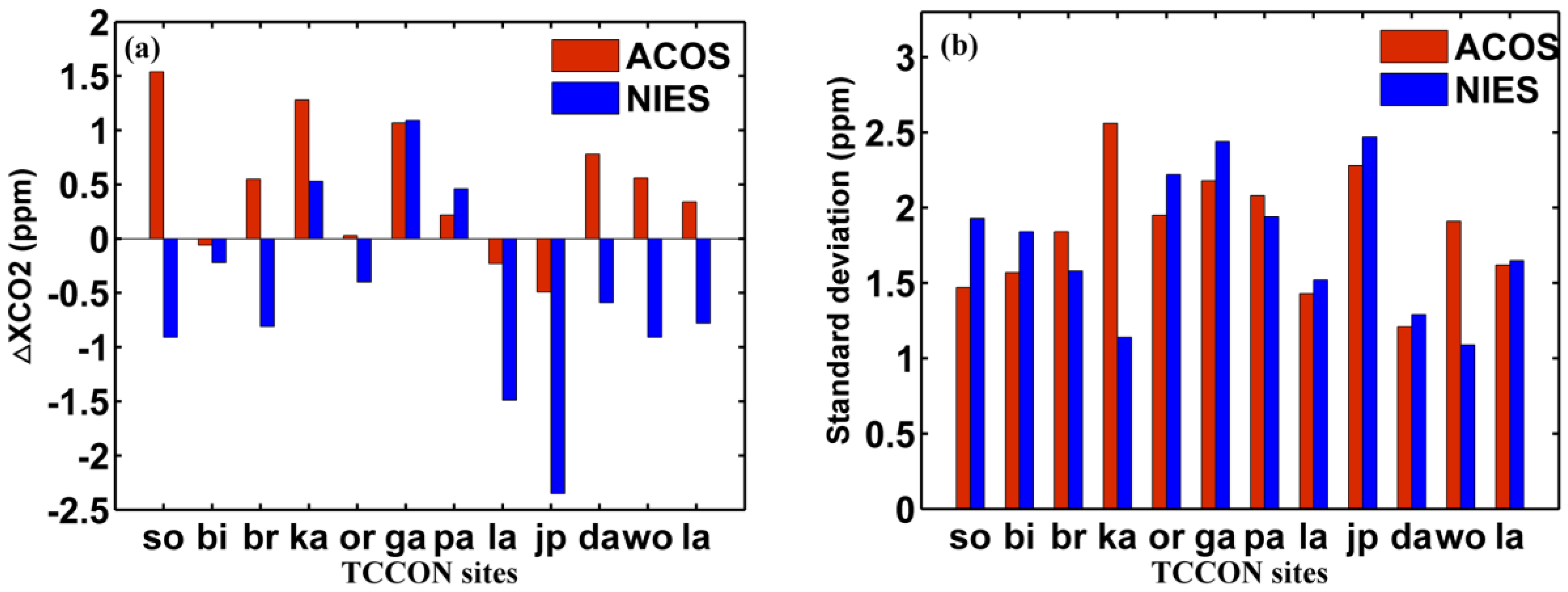
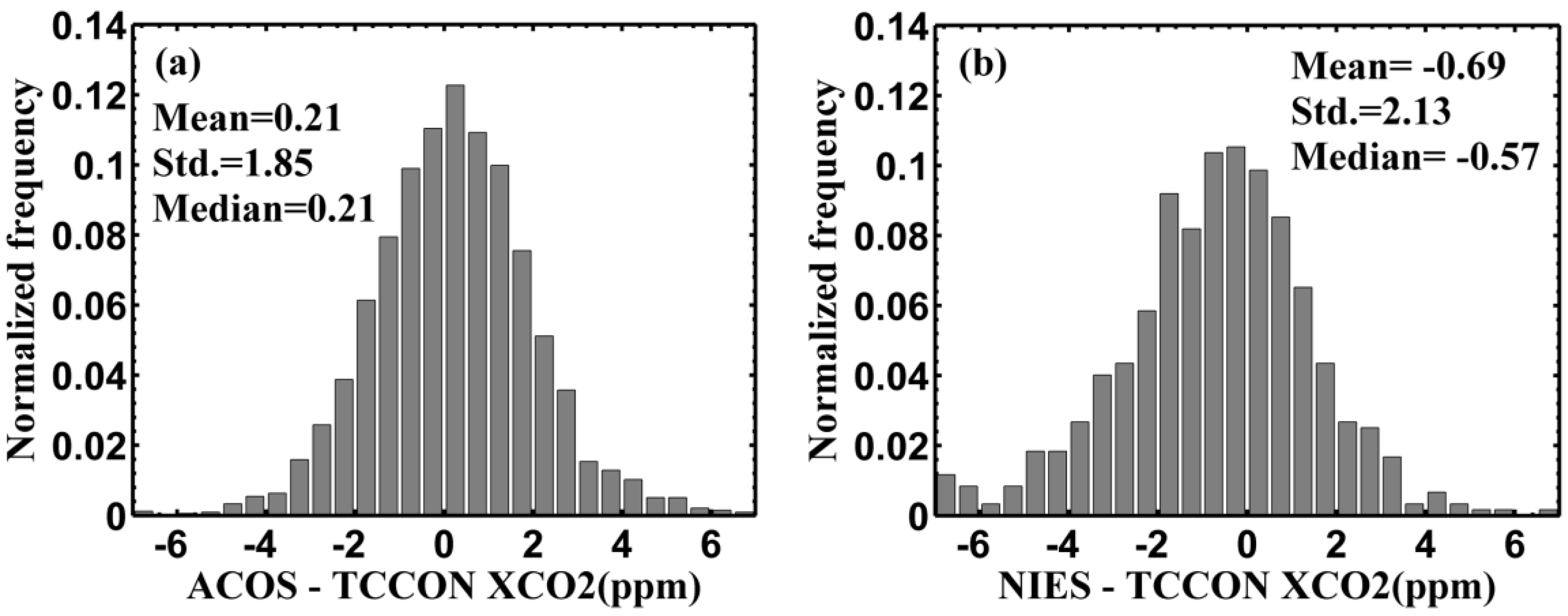
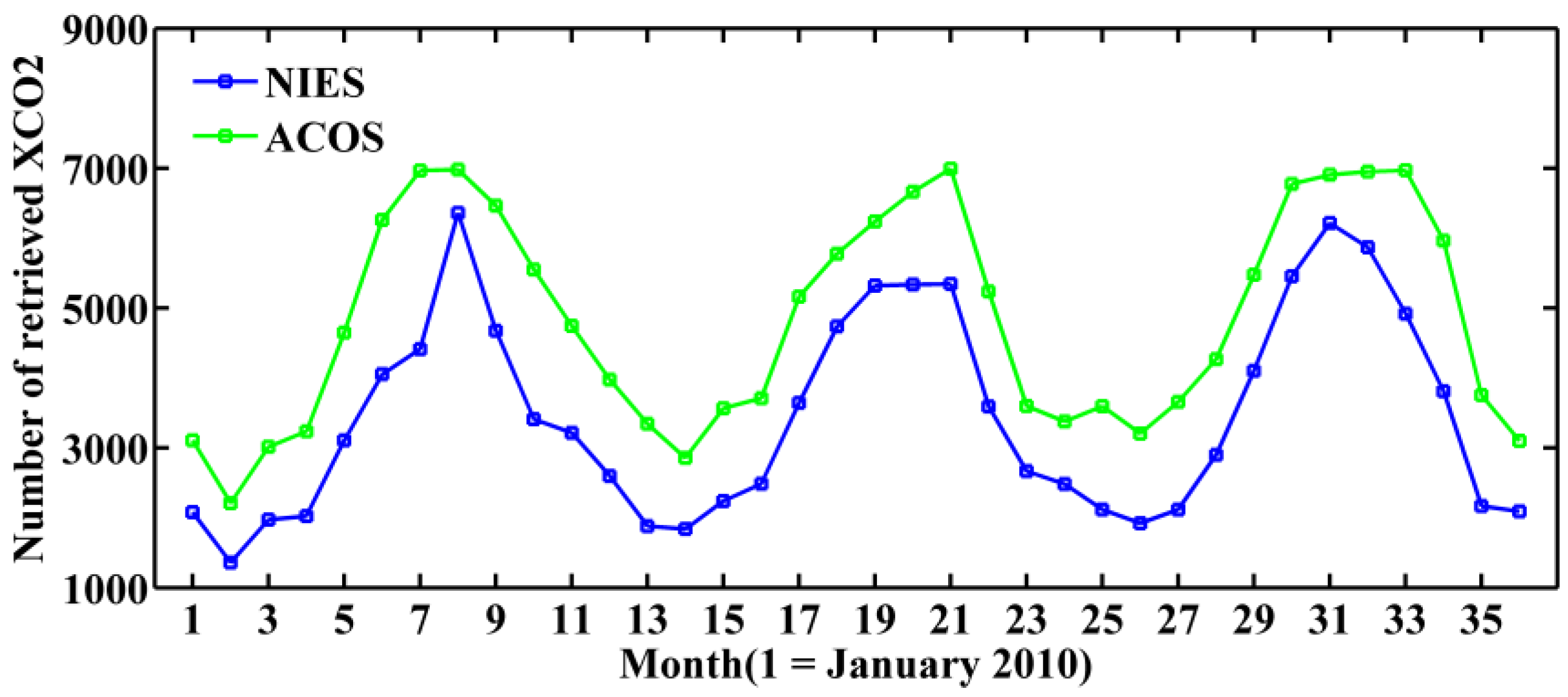
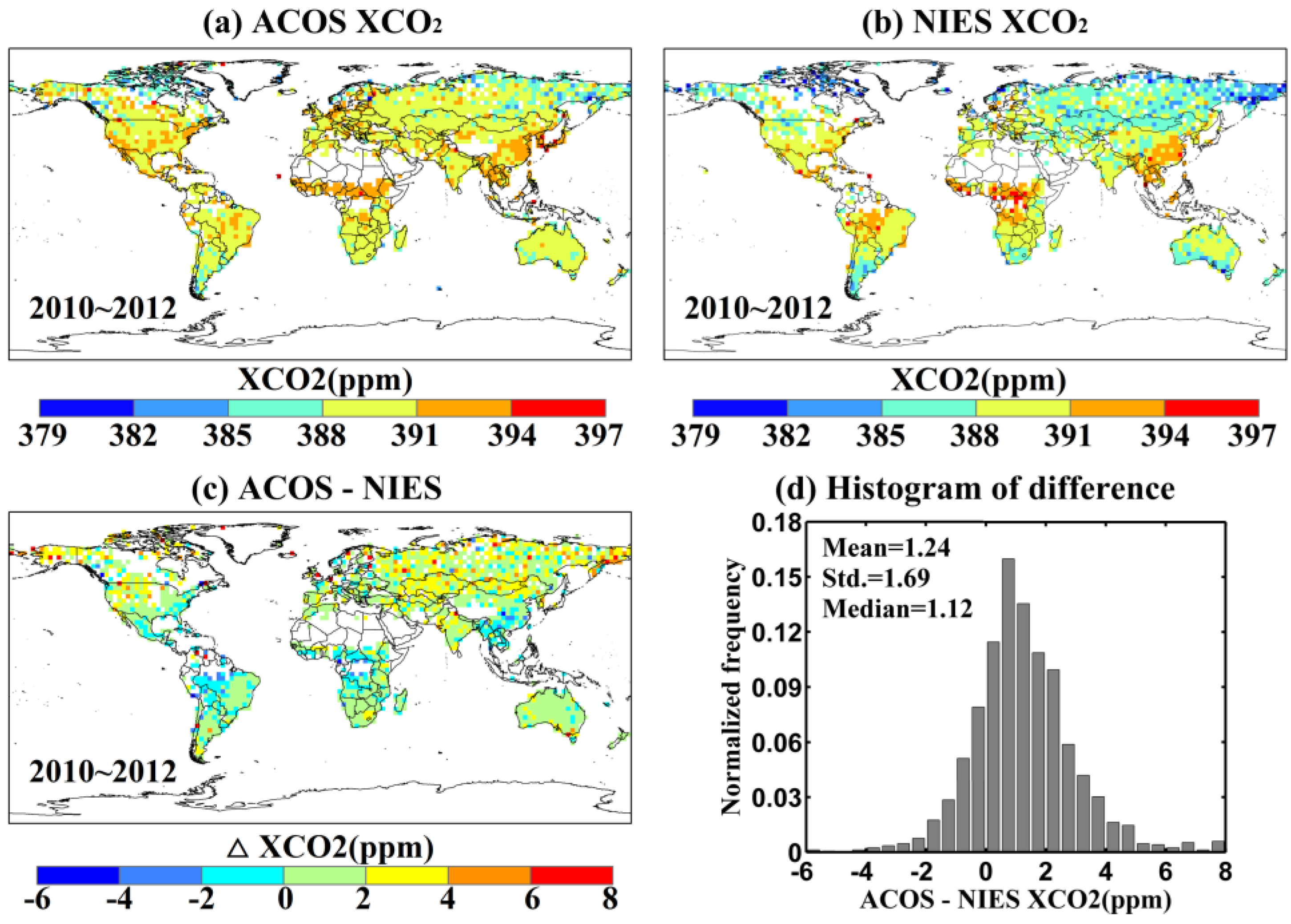
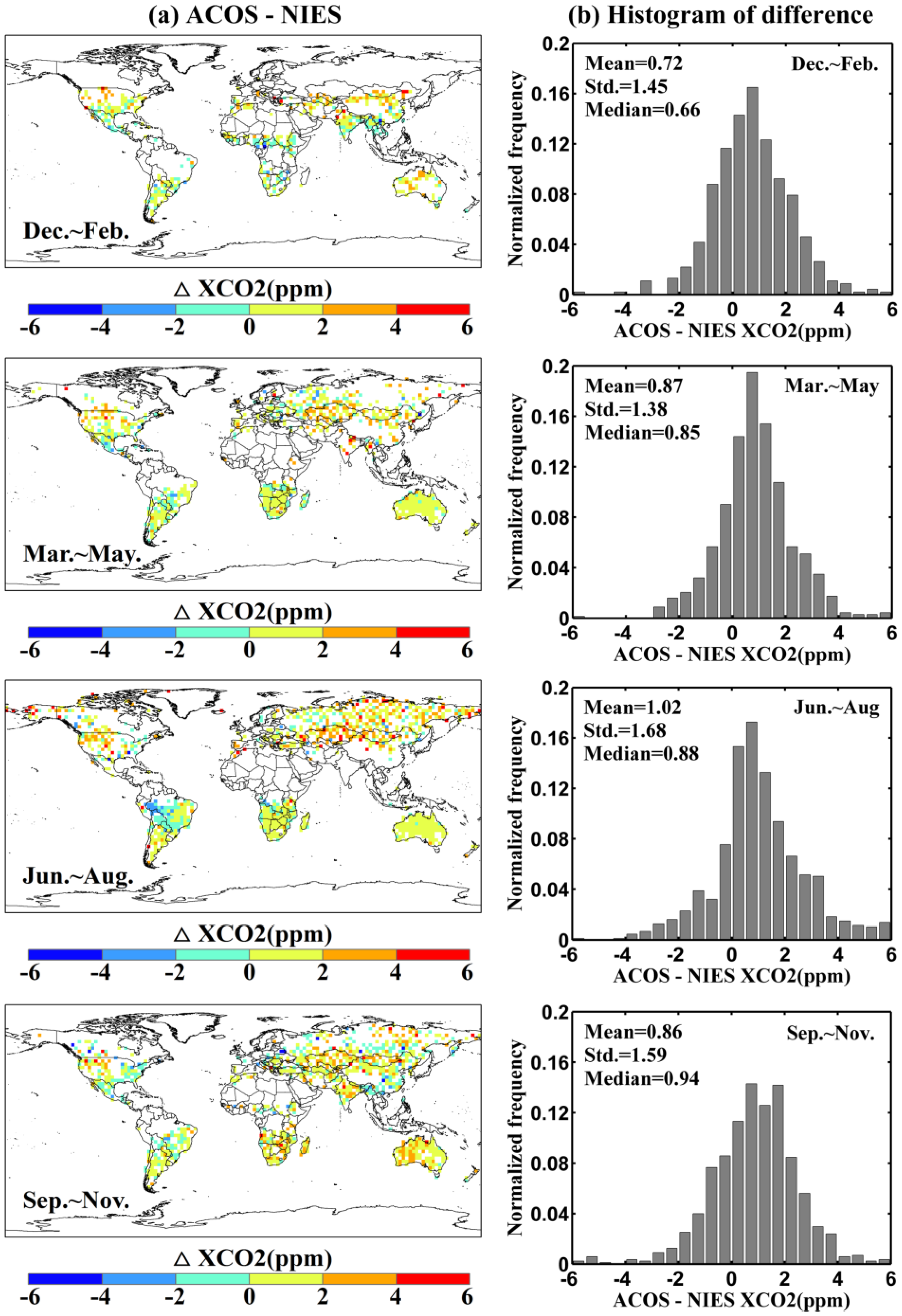
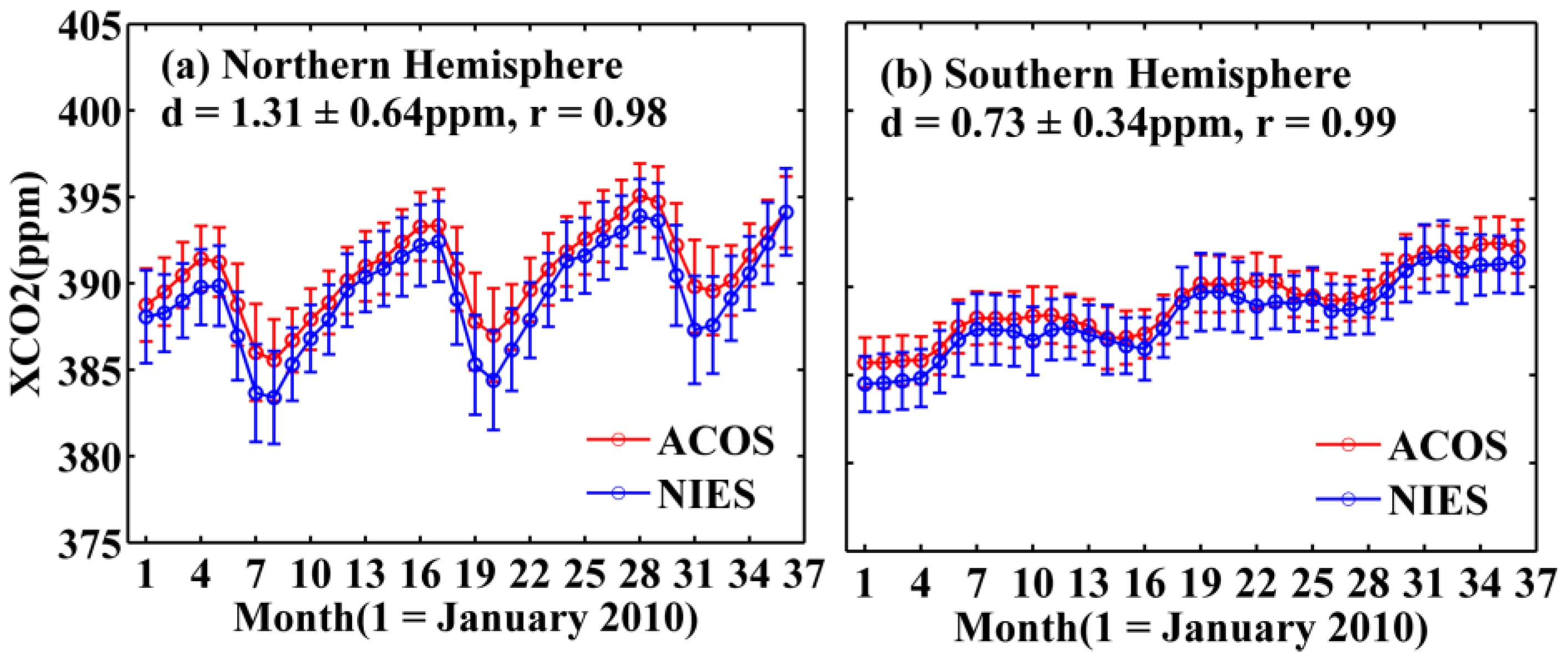
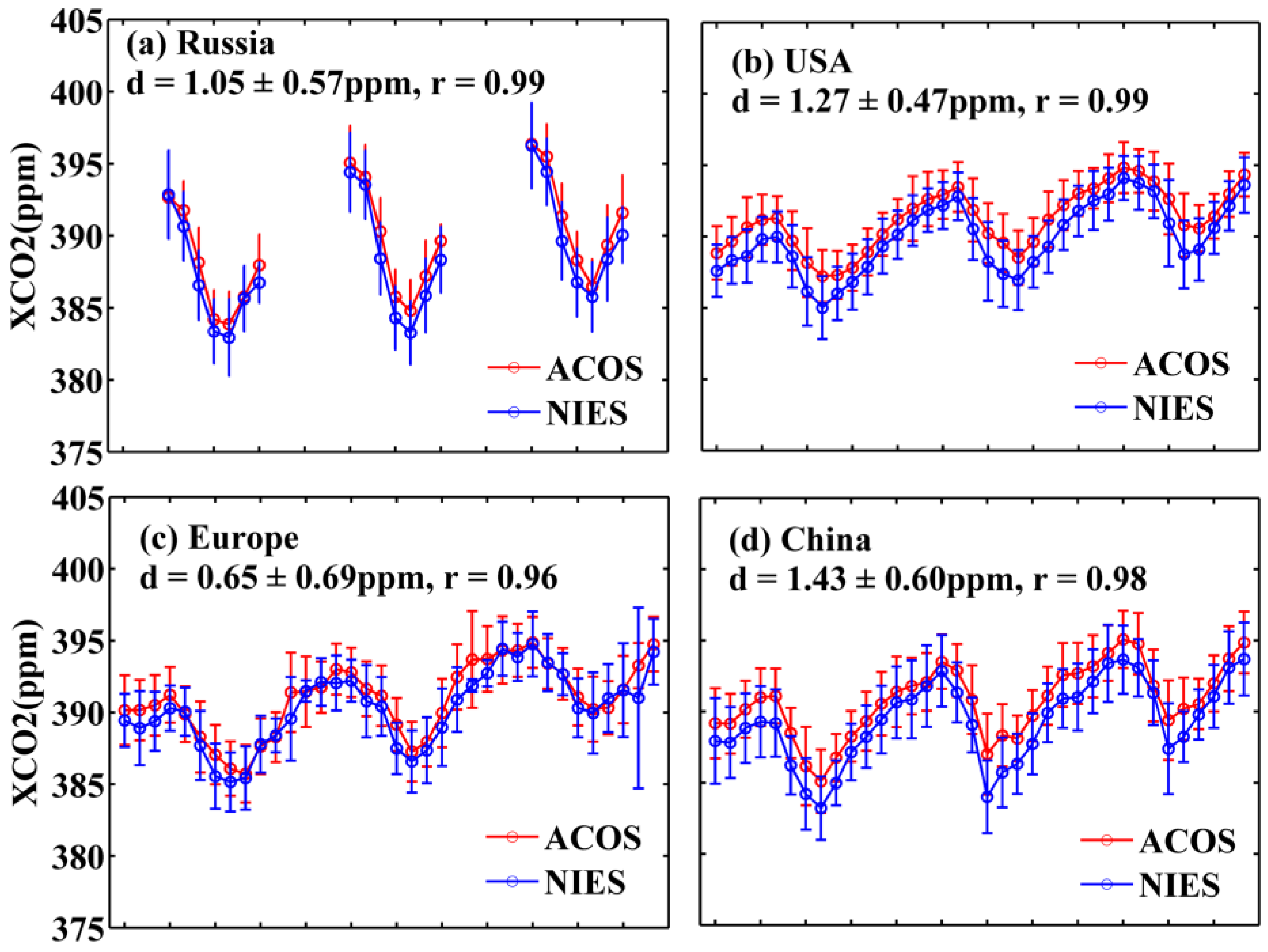
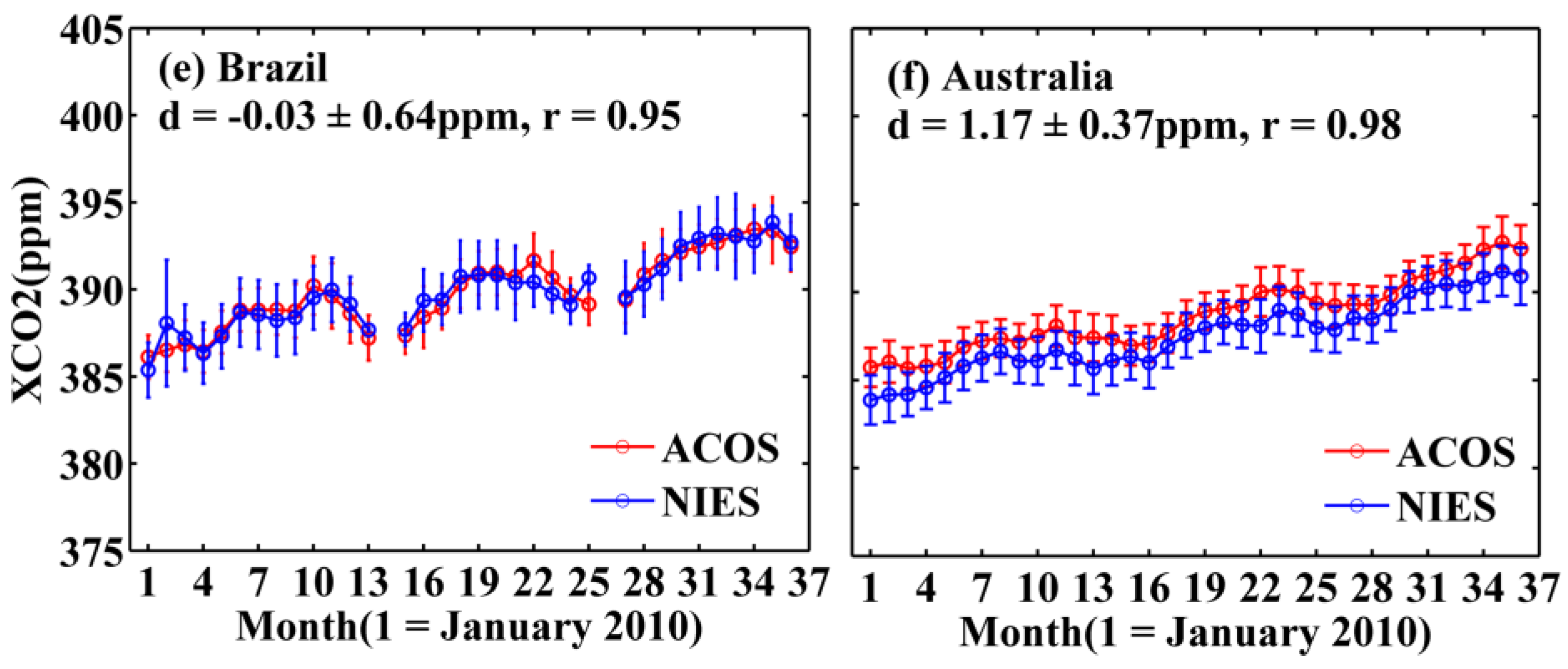
| Sites | ACOS—TCCON | NIES—TCCON | ||||||
|---|---|---|---|---|---|---|---|---|
| n | d (ppm) | std (ppm) | r | n | d (ppm) | std (ppm) | r | |
| Sodankyla (67.37°N, 26.63°E) | 50 | 1.54 | 1.47 | 0.91 | 45 | −0.91 | 1.93 | 0.89 |
| Bialystok (53.23°N, 23.02°E) | 93 | −0.06 | 1.57 | 0.88 | 23 | −0.22 | 1.84 | 0.78 |
| Bremen (53.10°N, 8.85°E) | 44 | 0.55 | 1.84 | 0.82 | 7 | −0.81 | 1.58 | 0.66 |
| Karlsruhe (49.1°N, 8.44°E) | 131 | 1.28 | 2.56 | 0.62 | 10 | 0.53 | 1.14 | 0.85 |
| Orleans (47.97°N, 2.11°E) | 203 | 0.03 | 1.95 | 0.75 | 32 | −0.40 | 2.22 | 0.48 |
| Garmisch(47.48°N,11.06°E) | 212 | 1.07 | 2.18 | 0.75 | 22 | 1.09 | 2.44 | 0.74 |
| Park Falls (45.94°N, 90.27°W) | 239 | 0.22 | 2.08 | 0.84 | 130 | 0.46 | 1.94 | 0.85 |
| Lamont (36.6°N, 97.49°W) | 1170 | −0.23 | 1.43 | 0.88 | 27 | −1.49 | 1.52 | 0.87 |
| JPL, Pasadena (34.2°N, 118.18°W) | 267 | −0.49 | 2.28 | 0.69 | 111 | −2.35 | 2.47 | 0.68 |
| Darwin (12.43°S, 130.89°E) | 281 | 0.78 | 1.21 | 0.61 | 85 | −0.59 | 1.29 | 0.36 |
| Wollongong (34.41°S, 150.88°E) | 508 | 0.56 | 1.91 | 0.63 | 36 | −0.91 | 1.09 | 0.88 |
| Lauder (45.04°S, 169.68°E) | 126 | 0.34 | 1.62 | 0.77 | 70 | −0.78 | 1.65 | 0.76 |
| Global offset (ppm) | 0.47 | −0.53 | ||||||
| Regional precision (ppm) | 1.84 | 1.76 | ||||||
| Relative accuracy (ppm) | 0.62 | 0.93 | ||||||
| Mean correlation | 0.76 | 0.73 | ||||||
© 2016 by the authors; licensee MDPI, Basel, Switzerland. This article is an open access article distributed under the terms and conditions of the Creative Commons Attribution (CC-BY) license (http://creativecommons.org/licenses/by/4.0/).
Share and Cite
Deng, A.; Yu, T.; Cheng, T.; Gu, X.; Zheng, F.; Guo, H. Intercomparison of Carbon Dioxide Products Retrieved from GOSAT Short-Wavelength Infrared Spectra for Three Years (2010–2012). Atmosphere 2016, 7, 109. https://doi.org/10.3390/atmos7090109
Deng A, Yu T, Cheng T, Gu X, Zheng F, Guo H. Intercomparison of Carbon Dioxide Products Retrieved from GOSAT Short-Wavelength Infrared Spectra for Three Years (2010–2012). Atmosphere. 2016; 7(9):109. https://doi.org/10.3390/atmos7090109
Chicago/Turabian StyleDeng, Anjian, Tao Yu, Tianhai Cheng, Xingfa Gu, Fengjie Zheng, and Hong Guo. 2016. "Intercomparison of Carbon Dioxide Products Retrieved from GOSAT Short-Wavelength Infrared Spectra for Three Years (2010–2012)" Atmosphere 7, no. 9: 109. https://doi.org/10.3390/atmos7090109






